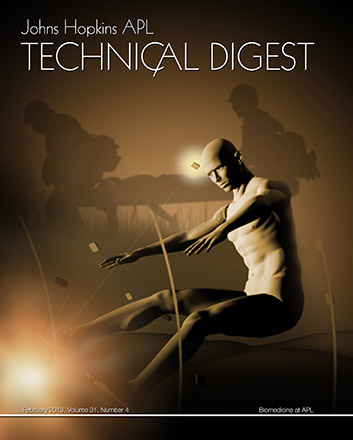
Biomedicine at APL
Volume 31, Number 4 (2013)
This issue of the Johns Hopkins APL Technical Digest is the second of two issues devoted to biomedical science and technologies being pursued by APL's Research and Exploratory Development Business Area. The Revolutionizing Prosthetics program has been a model for integrating scientific research and advanced development across an expansive multidisciplinary and multiorganizational team. This proven capability has led to significant advances in many areas, including applied neuroscience, dexterous robotics, injury mitigation systems, patient-centered care, explosive ordnance disposal robotics, and systems engineering for improved patient safety. With extraordinary advances in genetics, molecular biology, cognitive science, bioinformatics, and biomaterials, the Laboratory will continue to address emerging challenges of national and global significance that will likely be the subject of future issues.
Biomedicine at APL: Guest Editor's IntroductionJohn D. Bigelow |
Biomechanics and Injury Mitigation Systems Program: An Overview of Human Models for Assessing Injury Risk in Blast, Ballistic, and Transportation Impact ScenariosAndrew C. Merkle, Catherine M. Carneal, Ian D. Wing, Alexis C. Wickwire, Jeffrey M. Paulson, Kyle A. Ott, Emily E. Ward, Timothy P. Harrigan, Jack C. Roberts, Bliss G. Carkhuff, and Trent M. Taylor |
Military-Relevant Traumatic Brain Injuries: A Pressing Research ChallengeIbolja Cernak |
Medical Communications for Combat Casualty CareJohn H. Benson, William A. Irizarry-Cruz, Jerrold E. Dietz, Jorge A. Aviles, Christian D. Reid, M. Shane Stephens, and Kristen N. Steinman |
Joint Trauma Analysis and Prevention of Injury in Combat (JTAPIC) ProgramRussell Paul Cain, Thomas E. Johnson, and M. Steve Rountree |
Human Capabilities Projection: Dexterous Robotic Telemanipulation with Haptic FeedbackMatthew S. Johannes, Robert S. Armiger, Michael J. Zeher, Matthew V. Kozlowski, John D. Bigelow, and Stuart D. Harshbarger |
Advancing Information Superiority Through Applied NeuroscienceR. Jacob Vogelstein |
Implementing Genome-Informed Personalized Medicine in the U.S. Air Force Medical Service via the Patient-Centered Precision Care Research (PC2-Z) ProgramChristopher E. Bradburne, Lucy M. Carruth, Jeffrey S. Lin, Ashok Sivakumar, John H. Benson, and Ruth A. Vogel |
Enabling Closed-Loop Control of the Modular Prosthetic Limb Through Haptic FeedbackRobert S. Armiger, Francesco V. Tenore, Kapil D. Katyal, Matthew S. Johannes, Alexander Makhlin, Mandy L. Natter, J. Edward Colgate, Sliman J. Bensmaia, and R. Jacob Vogelstein |
Systems Approach and Systems Engineering Applied to Health Care: Improving Patient Safety and Health Care DeliveryAlan D. Ravitz, Adam Sapirstein, Julius C. Pham, and Peter A. Doyle |
Revolutionizing Prosthetics—Phase 3Alan D. Ravitz, Michael P. McLoughlin, James D. Beaty, Francesco V. Tenore, Matthew S. Johannes, Scott A. Swetz, John B. Helder, Kapil D. Katyal, Matthew P. Para, Kenneth M. Fischer, Timothy C. Gion, and Brock A. Wester |